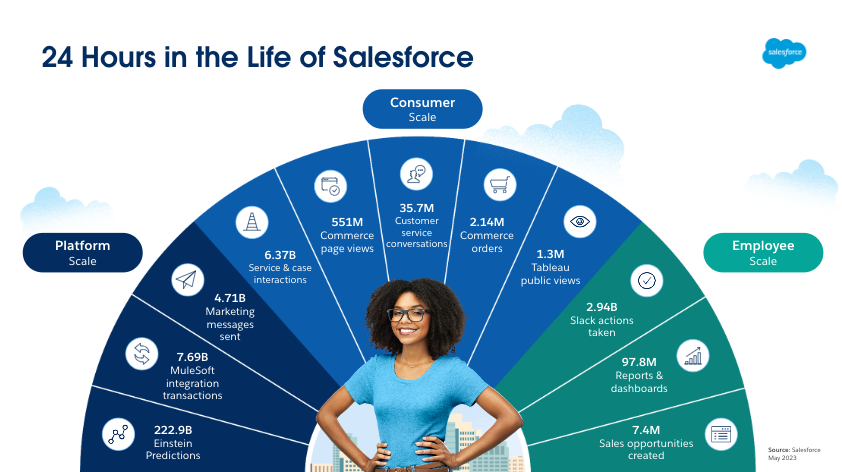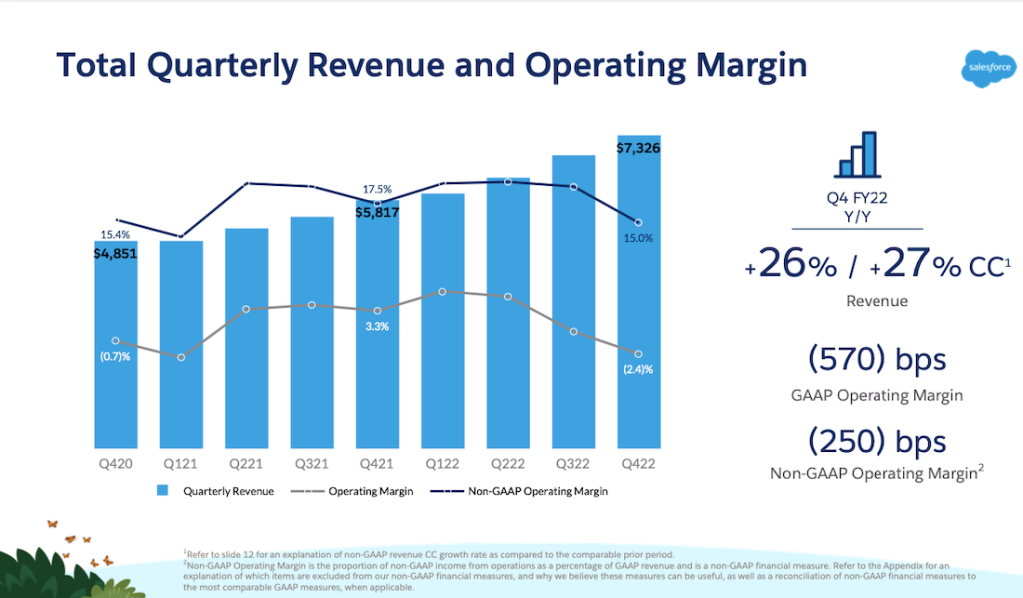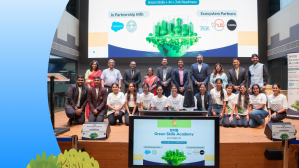Editor’s Note: This page was last updated in March 2023. For media inquiries about Salesforce and its operations, please contact PR@salesforce.com.
You’ve asked and Salesforce has answered.
This page answers popular questions about Salesforce, plus some fun facts even long-time employees might not know.
1. How many employees does Salesforce have?
Salesforce has over 72,000 employees globally.
This represents a 30% growth in employees since the same time in 2020. For context, Salesforce employees would overflow the American football stadium, Levi’s Stadium, where the San Francisco 49ers play.
While growing at a rapid pace, Salesforce remains intentional about company culture and employee experience. The company was named a top 5 employer in eleven countries, including the #1 employer in France, Spain and the Netherlands.
Additionally, Salesforce was named the #4 World’s Best Workplace.
2. What does Salesforce do?
Bet Astro wishes they had a nickel for every time this question came up. The company has evolved and grown so much since it was founded in 1999 — and as its size and scope have increased, so has the complexity of this answer. Salesforce, the global CRM leader, empowers companies of every size and industry to connect with their customers in a whole new way through the power of AI + data + CRM. For more, check out this article on Salesforce’s The 360 Blog.

3. How much information does Salesforce process in 24 hours?
Salesforce brings companies and customers together. In other words, it powers trillions of platform, consumer and employee interactions.
We power Platform at scale with 4.71 billion messages sent, Consumer at scale with 6.37 billion service and case interactions, and Employee at scale with more than 2.94 billion Slack actions taken — all in one day.
Platform:
- 222.9B Einstein Predictions
- 7.69B MuleSoft integration transactions
- 4.71B Marketing messages sent
Consumer:
- 6.37B Service & case interactions
- 551M Commerce page views
- 35.7M Customer service conversations
- 2.14M Commerce orders
- 1.3M Tableau public views
Employee:
- 2.94B Slack actions taken
- 97.8M Reports & dashboards
- 7.4M Sales opportunities created
4. What is Salesforce’s annual revenue?
In its 2023 fiscal year, Salesforce achieved $31.4 billion in revenue, a record high. See more on the Investor Relations page.
5. Where does Salesforce operate around the world?
Salesforce operates in 84 cities, with 95 offices around the world. There are eight Salesforce Towers currently (in Atlanta, Indianapolis, London, New York, San Francisco, Tokyo, Dublin, and Chicago) with another one in development (Salesforce Tower Sydney).
See specific Salesforce office locations or browse the media library for images.
6. How tall is the Salesforce tower in San Francisco?
1,070 feet. Opened in 2018, the Salesforce Tower in San Francisco is 61 stories and 1.4 million square feet of office space.
Fun facts about the Salesforce Tower in San Francisco:
- The Salesforce Tower has one of the largest onsite water recycling systems in a commercial high-rise in the United States — and the first of its kind in San Francisco. The system filters up to 30,000 gallons of water from sinks, toilets, and showers every day then safely repurposes it for non-potable uses. The water savings is equivalent to over 7.8 million gallons a year — about the same amount of water used by 16,000 local residents.
- It takes 39 seconds to travel by elevator from street level to the 61st floor, and 1,762 total steps if you choose to take the stairs.
- The Salesforce Tower foundation is socketed into bedrock, more than 318 feet in the ground.
- 12,000 tons of steel were used in the construction of Salesforce Tower.
- It took over 2.5 million people hours to build.
Learn more about the San Francisco Salesforce Tower.
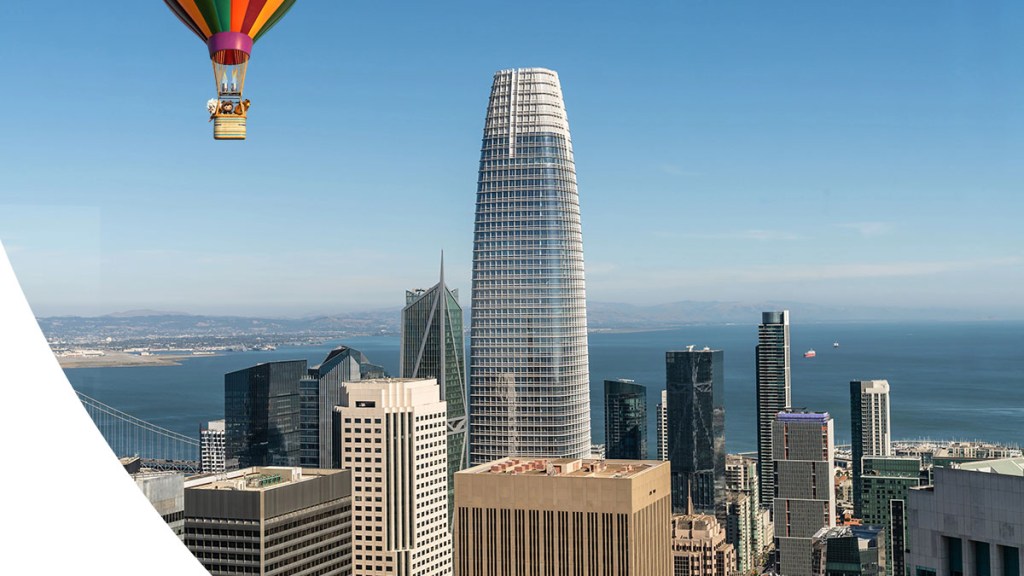
7. How diverse is Salesforce?
In 2017, Salesforce began publishing diversity data. Then in 2019, the company published four new representation goals to continue to drive transparency and accountability toward our equality efforts. We’ve met two of those goals early, doubling U.S. representation of Black leaders (VP and above) and increasing representation of underrepresented groups to more than half of our U.S. population. Last year, we added an additional representation goal to reach 40% women identifying and non-binary employees globally by the end of 2026.
See our annual equality update from February 2023.
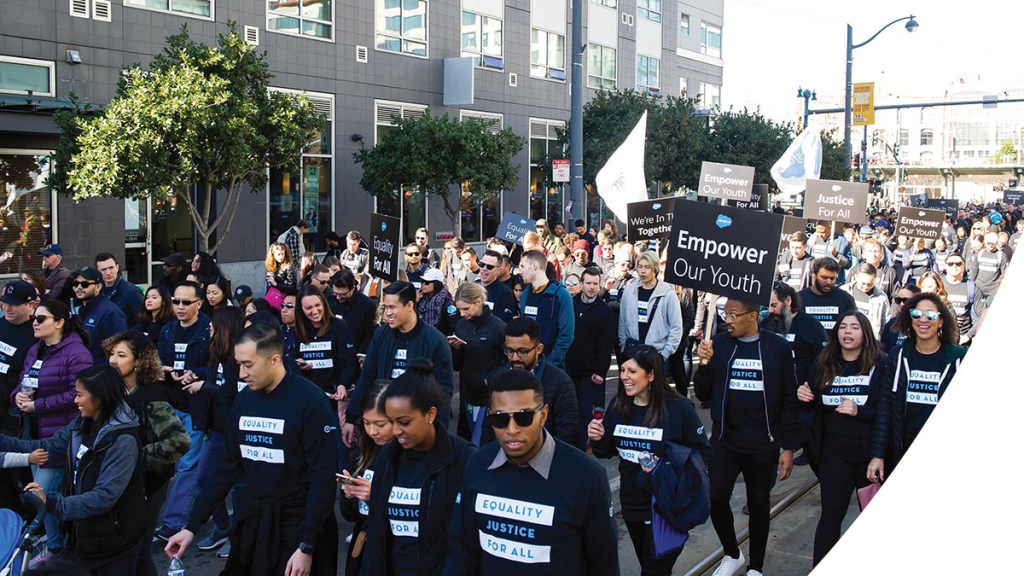
8. How does Salesforce ensure equality in employee salaries?
In 2015, Salesforce was one of the first companies to evaluate and address any gaps in pay among its global workforce across gender globally and race in the U.S. Since then, Salesforce has continued to improve upon its processes and broaden the scope of assessment to include bonuses, promotions, and stock.
9. How is Salesforce a sustainable company?
In 2021, Salesforce achieved net zero residual emissions across its full value chain and reached 100% renewable energy for its global operations. This means Salesforce has purchased enough renewable energy to match all electricity it uses globally.
Since first committing to this goal in 2013, Salesforce has been working to accelerate the global transition to clean and renewable sources of electricity with the aim for a future where renewable energy is powering the world around the clock.
Earlier this year, Salesforce announced its Nature Positive Strategy outlining specific actions the company will take to accelerate its existing commitment to net zero. Salesforce has also established sustainability as a core company value and made its carbon accounting solution, Net Zero Cloud, available globally.

Sustainability priorities to drive toward a 1.5°C future with its Climate Action Plan include: emissions reduction, carbon removal, trillion trees & ecosystem restoration, education & mobilization, innovation, and regulation & policy — offering others a blueprint to accelerate their journey to net zero. In line with our sustainability priorities, Salesforce also co-founded 1t.org, the global movement to conserve, restore and grow 1 trillion trees by 2030 and launched an Ocean Sustainability Program to help protect our ocean.

See the latest Salesforce sustainability news.
10. How much has Salesforce given back to the community?
Since its founding, the company has:
- Donated a total of $621 million in grants
- Provided 8.1M service hours through employee volunteerism
- Supported 54K nonprofit and higher education customers through our software
Salesforce is a Pledge 1% founder, member, and champion. Following the 1-1-1 model that Salesforce pioneered, Pledge 1% encourages companies to dedicate any combination of 1% time, 1% product, and 1% profit or 1% equity to improving the world.
Since its launch, more than 17,000 companies from over 100 countries have joined Salesforce in the Pledge 1% movement. Combined, they have set aside equity for social impact, igniting approximately $2 Billion USD in new philanthropy.
11. What is Salesforce’s economic impact?
In 2021, IDC completed a study that looked at the economic impact of cloud computing in terms of the revenues it creates and jobs generated by those revenues.
The study showed that by 2026, Salesforce and its ecosystem of partners will:
- Create 9.3 million new jobs
- Bring $1.6 trillion in new business revenue
And, for every $1 Salesforce makes, partners will make $6.19.
12. How big is Salesforce’s Trailblazer Community?
The Trailblazer Community is a network of 19.5 million people across the Salesforce ecosystem who help each other learn new skills and succeed with Salesforce. Salesforce celebrates Trailblazers — pioneers, innovators, and lifelong learners. One such Trailblazer is Tony Nguyen, who went from a laid-off restaurant manager to earning a Golden Hoodie, one of the highest honors in the Salesforce Trailblazer Community, given to those who exemplify inspiration and innovation.
To become certified in Salesforce, anyone can start by checking out Trailhead, the free online learning platform that more than 5.9 million people have used to learn Salesforce skills and connect with other learners on the Trailblazer Community.
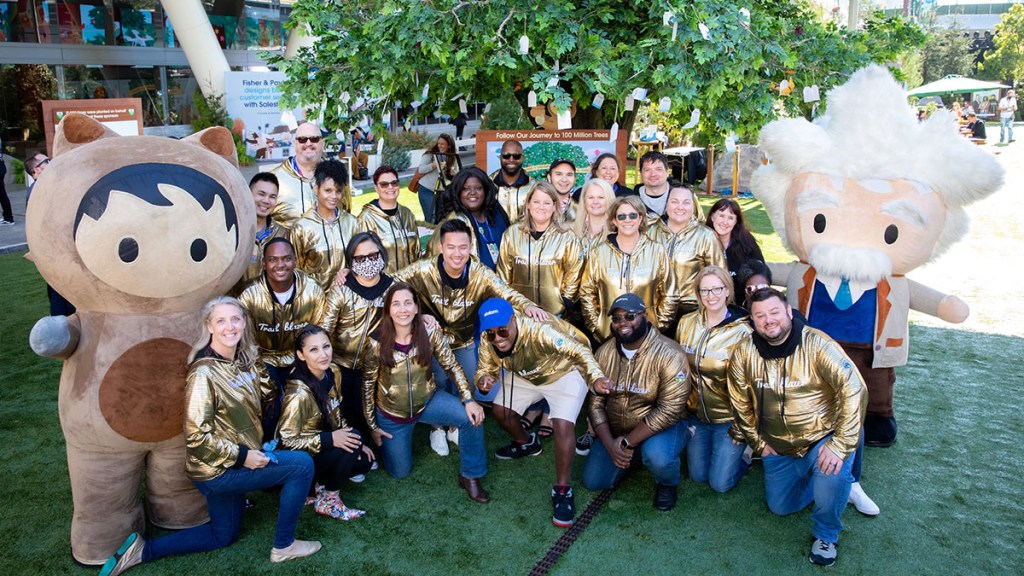
More information
Learn about the history of Salesforce.



